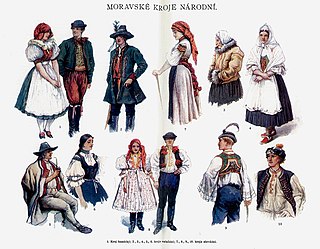Czech, historically also known as Bohemian, is a West Slavic language of the Czech–Slovak group, written in Latin script. Spoken by over 10 million people, it serves as the official language of the Czech Republic. Czech is closely related to Slovak, to the point of high mutual intelligibility, as well as to Polish to a lesser degree. Czech is a fusional language with a rich system of morphology and relatively flexible word order. Its vocabulary has been extensively influenced by Latin and German.
Slovak is a West Slavic language of the Czech–Slovak group, written in Latin script. It is part of the Indo-European language family, and is one of the Slavic languages, which are part of the larger Balto-Slavic branch. Spoken by approximately 5 million people as a native language, primarily ethnic Slovaks, it serves as the official language of Slovakia and one of the 24 official languages of the European Union.

Moravians are a West Slavic ethnographic group from the Moravia region of the Czech Republic, who speak the Moravian dialects of Czech or Common Czech or a mixed form of both. Along with the Silesians of the Czech Republic, a part of the population to identify ethnically as Moravian has registered in Czech censuses since 1991. The figure has fluctuated and in the 2011 census, 6.01% of the Czech population declared Moravian as their ethnicity. Smaller pockets of people declaring Moravian ethnicity are also native to neighboring Slovakia.

The Kaiser roll, also called a Vienna roll, or a hard roll, is a typically round bread roll, originally from Austria. It is made from white flour, yeast, malt, water and salt, with the top side usually divided in a symmetric pattern of five segments, separated by curved superficial cuts radiating from the centre outward or folded in a series of overlapping lobes resembling a crown. The crisp Kaisersemmel is a traditional Austrian food officially approved by the Federal Ministry of Agriculture.
An etymological dictionary discusses the etymology of the words listed. Often, large dictionaries, such as the Oxford English Dictionary and Webster's, will contain some etymological information, without aspiring to focus on etymology.

The Czech Republic's official long and short names at the United Nations are Česká republika and Česko in Czech, and the Czech Republic and Czechia in English. All these names derive from the name of the Czechs, the West Slavic ethnolinguistic group native to the Czech Republic. Czechia, the official English short name specified by the Czech government, is used by many international organisations.

The Institute of the Czech Language is a scientific institution dedicated to the study of the Czech language. It is one of the institutes of the Academy of Sciences of the Czech Republic. Its headquarters are in Prague and it has a branch in Brno.

Moravian dialects are the varieties of Czech spoken in Moravia, a historical region in the east of the Czech Republic. There are more forms of the Czech language used in Moravia than in the rest of the Czech Republic. The main four groups of dialects are the Bohemian-Moravian group, the Central Moravian group, the Eastern Moravian group and the Lach (Silesian) group. While the forms are generally viewed as regional variants of Czech, some Moravians claim them to be one separate Moravian language.

The Czechoslovak language was a political sociolinguistic concept used in Czechoslovakia in 1920–1938 for the definition of the state language of the country which proclaimed its independence as the republic of two nations, i.e. ethnic groups, Czechs and Slovaks.

Aleš Klégr is a Czech linguist, professor of English language at Charles University in Prague. He specializes, among others, in lexicology, lexicography, semantics and morphology.

Dušan Zbavitel was a Czech indologist.
While many Slavic languages officially use Latin-derived names for the months of the year in the Gregorian calendar, there is also a set of older names for the twelve months that differs from the Latin month names, as they are of Slavic origin. In some languages, such as the Serbian language these traditional names have since been archaized and are thus seldom used.

Emanuel Max, after 1876: Ritter von Wachstein was a sculptor un the Austrian Empire and later Austria-Hungary. His brother was the sculptor Josef Max.

Mons. ThDr. Oto Mádr, dr. h. c. was a Czech Roman Catholic priest, theologian, university professor, long-time political prisoner and the chief editor of Theological Texts.

Miloslav Petrusek was a prominent Czech sociologist who served as a dean of Faculty of Social Sciences at Charles University in Prague between 1992–1997, as well as the prorector for academic affairs of the university in 1997–2000. For his consistent contribution to sociology and education, he received numerous awards, such as Ordre des Palmes Académiques or Golden Medal of Masaryk University. In 2012, Petrusek received The VIZE 97 Prize.
Václav Chaloupecký was a Czech historian, a student of prominent Czech historian Josef Pekař and the main representative of historians in mid-war Slovakia.

Chapel of Our Lady of Sorrows is a chapel in Beroun in the Central Bohemian Region of the Czech Republic. It is located on one of the highest points of the town. On 3 May 1958 the chapel was officially listed as a cultural heritage site.

František Salzer was a Czechoslovak Theatre Director, Theatre Actor, Film Actor, University Professor and Translator.

Antonín Popp was a Czech sculptor, medallist and teacher.

The Supreme Burgrave of the Kingdom of Bohemia, originally the Burgrave of Prague or the Burgrave of Prague Castle was the most important land official of the Kingdom of Bohemia. They were the head of the Bohemian Diet and the Bohemian land court, and commander of the Zemská hotovost.